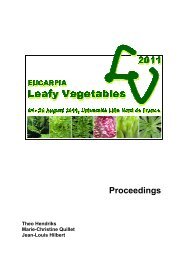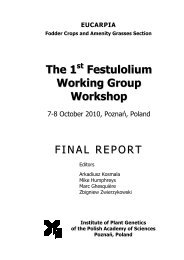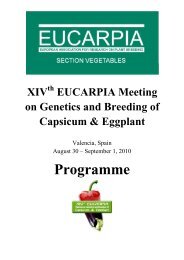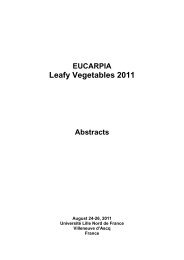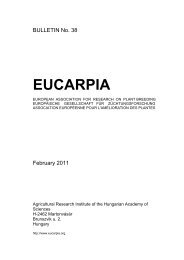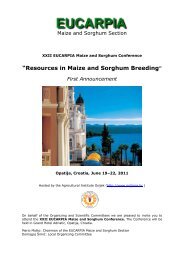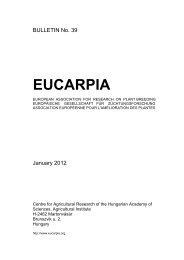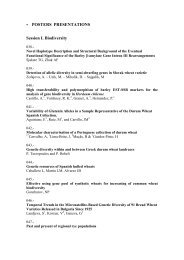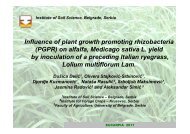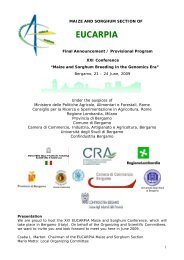Plant breeding for organic and sustainable, low-input agriculture
Plant breeding for organic and sustainable, low-input agriculture
Plant breeding for organic and sustainable, low-input agriculture
You also want an ePaper? Increase the reach of your titles
YUMPU automatically turns print PDFs into web optimized ePapers that Google loves.
Agronomic properties of triticale (x Triticosecale wittmack) selected <strong>for</strong> tolerance to<br />
nutrition deficiency under laboratory conditions.<br />
Danuta Rzepka-Plevneš 1 , Marta Stępień-Słodkowska 2<br />
1 Agricultural University of Szczecin, Pol<strong>and</strong>; 2 University of Szczecin, Pol<strong>and</strong><br />
Mineral nutrient that are taken up by plant roots are essential <strong>for</strong> plant growth <strong>and</strong> crop<br />
production. The macronutrients nitrogen, phosphorus <strong>and</strong> potassium are frequently added to soil<br />
where crops are grown, because they contain either deficit or suboptimal levels of these nutrients<br />
(Marschner 1995, Shin et al. 2005).<br />
The studies were conducted over the years 2001-2002 <strong>and</strong> covered 26 varieties of triticale<br />
examined <strong>for</strong> tolerance to nitrogen <strong>and</strong> potassium deficiency under in vitro cultures of mature<br />
embryos. The selection of tolerant <strong>and</strong> partially tolerant seedlings was per<strong>for</strong>med 10 days after<br />
the growth initiation of triticale embryos on a MS medium containing 0.333 mM ⋅ dm -3 nitrogen,<br />
0.225 mM ⋅ dm -3 phosphorus <strong>and</strong> 0.332 mM ⋅ dm -3 potassium. The MS medium with a full NPK<br />
composition (N - 6.003 mM ⋅ dm -3 , P - 0.125 mM ⋅ dm -3 , K - 2.005 mM ⋅ dm -3 ) comprised the<br />
control medium. Seedlings longer than 5 cm with two well <strong>for</strong>med leaves <strong>and</strong> well branched<br />
seminal roots were classified as tolerant, with reduced height to 2.5 cm <strong>and</strong> developed roots - as<br />
partially tolerant to nitrogen <strong>and</strong> potassium deficiency. Seedlings tolerant <strong>and</strong> partially tolerant<br />
were planted into pit pots <strong>and</strong> after hardening in a glass-house, moved on 0.5 m 2 plots in the field<br />
experiment. The experiment was based on r<strong>and</strong>om blocks in three repeats in soil containing in a<br />
100 g of 0.11% total nitrogen, 12 mg P2O5 <strong>and</strong> 12 mg K2O. During the whole vegetation period<br />
no additional mineral fertilisation was applied. The control seeds of all tested triticale varieties<br />
were obtained from the breeders. The triticale properties were determined at the stage of full<br />
maturity – crop components from an area unit. The obtained results were evaluated statistically.<br />
The results obtained show that tolerant <strong>and</strong> partially tolerant seedlings, identified by way of<br />
selection at the stage of a mature plant, did not differ from the control plants as regards many of<br />
the properties examined. Some of them proved even superior as regards height, ear length,<br />
number of spikelets in ear, tillering, number of grains per plant <strong>and</strong> per ear. For most of the<br />
studied features, a significant correlation was observed, both in the tolerant <strong>for</strong>ms <strong>and</strong> in the<br />
control <strong>for</strong>ms. Special attention should be paid to two triticale varieties that in the in vitro test<br />
were described as partially tolerant (Bogo <strong>and</strong> Chrono) as well as eight varieties identified as<br />
susceptible (Lasko, Malno, Marko, Moreno, Mundo, Nemo, Prego, Pronto). The results obtained<br />
indicate that from Polish triticale varieties it is possible to select source material <strong>for</strong> <strong>breeding</strong> of<br />
varieties <strong>for</strong> extensive conditions of cultivation.<br />
38




